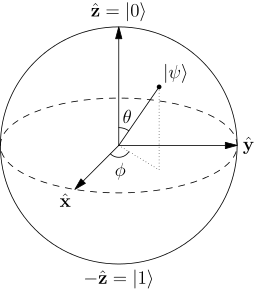BB84
BB84[1] is a quantum key distribution scheme developed by Charles Bennett and Gilles Brassard in 1984. It is the first quantum cryptography protocol.[2] The protocol is provably secure, relying on the quantum property that information gain is only possible at the expense of disturbing the signal if the two states one is trying to distinguish are not orthogonal (see no cloning theorem). It is usually explained as a method of securely communicating a private key from one party to another for use in one-time pad encryption.[3]
Description
In the BB84 scheme, Alice wishes to send a private key to Bob. She begins with two strings of bits,  and
and  , each
, each  bits long. She then encodes these two strings as a string of
bits long. She then encodes these two strings as a string of  qubits,
qubits,

 and
and  are the
are the  bits of
bits of  and
and  , respectively. Together,
, respectively. Together,  give us an index into the following four qubit states:
give us an index into the following four qubit states:




Note that the bit  is what decides which basis
is what decides which basis  is encoded in (either in the computational basis or the Hadamard basis). The qubits are now in states which are not mutually orthogonal, and thus it is impossible to distinguish all of them with certainty without knowing
is encoded in (either in the computational basis or the Hadamard basis). The qubits are now in states which are not mutually orthogonal, and thus it is impossible to distinguish all of them with certainty without knowing  .
.
Alice sends  over a public quantum channel to Bob. Bob receives a state
over a public quantum channel to Bob. Bob receives a state  , where
, where  represents the effects of noise in the channel as well as eavesdropping by a third party we'll call Eve. After Bob receives the string of qubits, all three parties, namely Alice, Bob and Eve, have their own states. However, since only Alice knows
represents the effects of noise in the channel as well as eavesdropping by a third party we'll call Eve. After Bob receives the string of qubits, all three parties, namely Alice, Bob and Eve, have their own states. However, since only Alice knows  , it makes it virtually impossible for either Bob or Eve to distinguish the states of the qubits. Also, after Bob has received the qubits, we know that Eve cannot be in possession of a copy of the qubits sent to Bob, by the no cloning theorem, unless she has made measurements. Her measurements, however, risk disturbing a particular qubit with probability ½ if she guesses the wrong basis.
, it makes it virtually impossible for either Bob or Eve to distinguish the states of the qubits. Also, after Bob has received the qubits, we know that Eve cannot be in possession of a copy of the qubits sent to Bob, by the no cloning theorem, unless she has made measurements. Her measurements, however, risk disturbing a particular qubit with probability ½ if she guesses the wrong basis.
Bob proceeds to generate a string of random bits  of the same length as
of the same length as  , and then measures the string he has received from Alice,
, and then measures the string he has received from Alice,  . At this point, Bob announces publicly that he has received Alice's transmission. Alice then knows she can now safely announce
. At this point, Bob announces publicly that he has received Alice's transmission. Alice then knows she can now safely announce  . Bob communicates over a public channel with Alice to determine which
. Bob communicates over a public channel with Alice to determine which  and
and  are not equal. Both Alice and Bob now discard the qubits in
are not equal. Both Alice and Bob now discard the qubits in  and
and  where
where  and
and  do not match.
do not match.
From the remaining  bits where both Alice and Bob measured in the same basis, Alice randomly chooses
bits where both Alice and Bob measured in the same basis, Alice randomly chooses  bits and discloses her choices over the public channel. Both Alice and Bob announce these bits publicly and run a check to see if more than a certain number of them agree. If this check passes, Alice and Bob proceed to use privacy amplification and information reconciliation techniques to create some number of shared secret keys. Otherwise, they cancel and start over.
bits and discloses her choices over the public channel. Both Alice and Bob announce these bits publicly and run a check to see if more than a certain number of them agree. If this check passes, Alice and Bob proceed to use privacy amplification and information reconciliation techniques to create some number of shared secret keys. Otherwise, they cancel and start over.
See also
References
- ↑ C. H. Bennett and G. Brassard. "Quantum cryptography: Public key distribution and coin tossing". In Proceedings of IEEE International Conference on Computers, Systems and Signal Processing, volume 175, page 8. New York, 1984. http://researcher.watson.ibm.com/researcher/files/us-bennetc/BB84highest.pdf
- ↑ Branciard, Cyril; Gisin, Nicolas; Kraus, Barbara; Scarani, Valerio (2005). "Security of two quantum cryptography protocols using the same four qubit states". Physical Review A 72 (3). arXiv:quant-ph/0505035. doi:10.1103/PhysRevA.72.032301.
- ↑ Quantum Computing and Quantum Information, Michael Nielsen and Isaac Chuang
| ||||||||||||||||||||||||||||||||||||||||||||||
